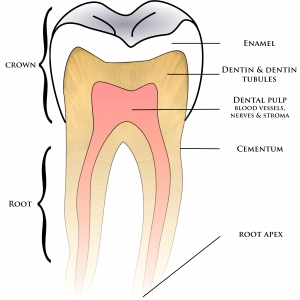The Anatomy of Teeth
Crown: the portion of the tooth that is visible above the gumline 
Root: the portion of the tooth that is not normally visible and is
below the gumline
Enamel: the outer covering of the tooth crown
Teeth are one of the body’s hardest naturally occurring substances. They are strong enough to adequately resist normal wearing that occurs over a lifetime of chewing food. Teeth are composed of several different parts: ¾ enamel, dentin, cementum, and pulp (nerve) tissue. The enamel is the outside covering of the tooth. It is the part of the tooth that you normally see when a person smiles. Yet, while enamel is very hard, it is also very brittle. It is mostly inorganic in nature. When fluoride is incorporated into the enamel (systemically when the enamel is forming, topically when the tooth is in the mouth), it becomes more resistant to acid attack and decay. The enamel of the tooth covers the inner layers of the crown portion of the tooth.
Dentin: the layer beneath the enamel
Dentin is not normally visible. Only when a tooth breaks or is worn can it be noticed. Dentin is darker in color, softer, and more resilient than enamel. Small nerve fibers running from the dentin to the pulp can make the tooth sensitive to temperature changes or other stimuli when dentin is exposed to the oral cavity. If a tooth is sensitive, many times, exposed dentin is the reason. Dentin, when exposed to the oral cavity, will wear away faster than enamel, and this can lead to other dental problems.
Pulp: the innermost tooth layer
The pulp of the tooth is composed of soft, highly organic material: ¾ mostly nerve fibers and blood vessels. When the pulp becomes damaged from deep decay or other dental problems, it can become abscessed and must then be treated with endodontic therapy (root canal) or be extracted.
Cementum: the outer covering of the root of the tooth
The root of a tooth is normally not seen. It is surrounded and covered by bone and gum tissue. The root is covered by a thin layer of cementum. Cementum is similar to dentin in composition and can decay or wear away if exposed in the mouth. Fibers that attach the tooth to the bone are embedded in the root cementum and serve as shock absorbers during normal functioning, such as chewing.
Bone: the structure that makes up the jaws
The bone that surrounds each tooth is less dense in the upper jaw and more dense in the lower jaw. As with bone elsewhere in the body, it can undergo resorption and repair. The spaces in which the teeth rest, called sockets, provide the pathways for a rich supply of blood and nutrients and other vital fluids to reach the teeth.
Are you passionate about dentistry? Do you want to make a difference in someone’s smile?
Star of Texas Dental Assisting School is looking for individuals who are passionate about getting into the healthcare field! Our Dental assisting program will teach you everything you need to know to be successful in today’s professional dental environments.

